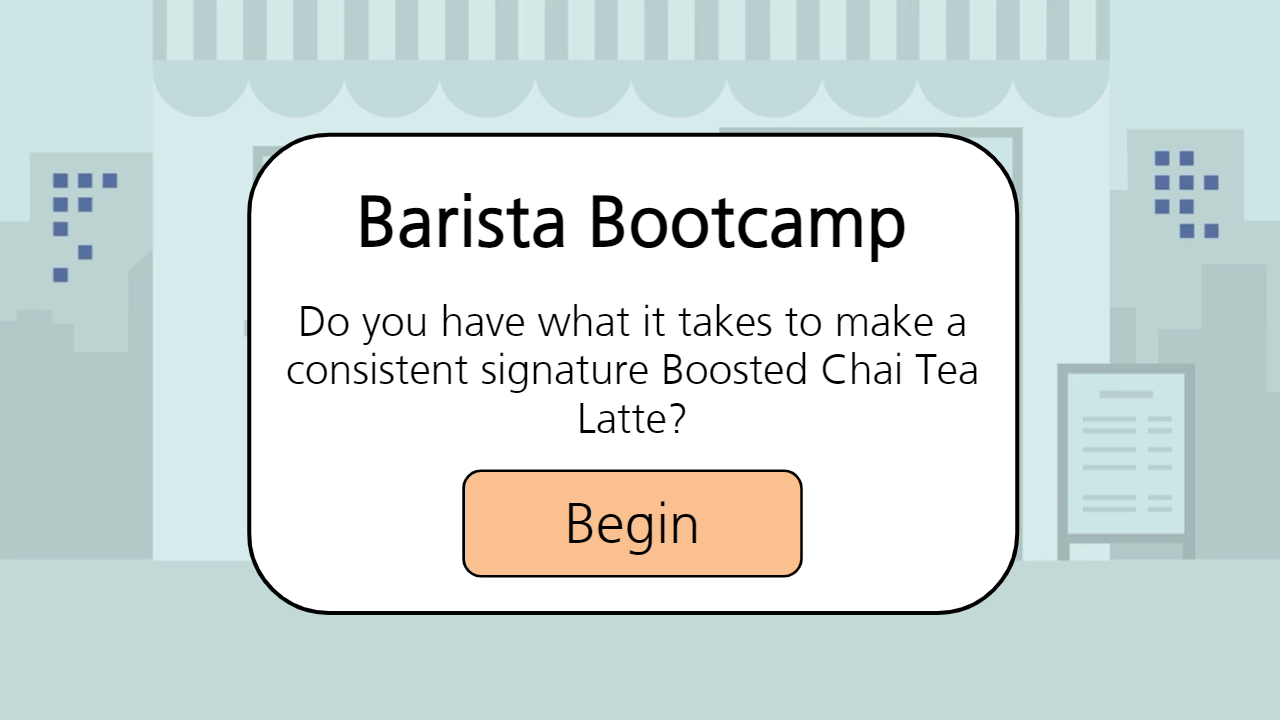Barista Bootcamp
This engaging scenario-based eLearning training teaches baristas how to craft the perfect signature drink.
Responsibilities: Instructional Designer, eLearning Developer
Target Audience: Baristas
Tools Used: Articulate Storyline 360, Vyond, Canva, Snagit, MindMeister
Year: 2023
KPI: Customer satisfaction surveys will be at or above 90% satisfaction rate 30 days after a new franchise opening.
Adult Learning Theory + Research Integration
-
According to an article by Harvard Business Publishing, “psychologist Jerome Bruner’s research suggests that facts are 20 times more likely to be remembered if they’re part of a story.” (2017)
This training is based on an immersive story where the learning is main character responsible for decision-making. The learner is an active participant in an engaging story instead of a passive observer of dry content.
-
Adult learning needs to be problem-centric and is best if it is immediately applicable to a current challenge.
Research shows that making errors during the learning process does NOT hinder learning. Thus, a solution-oriented, scenario-based approach relies on the concept of productive failure and challenge as a catalyst for learning.
From the book Make It Stick: “Trying to solve a problem before being shown the solution leads to better learning and longer retention of the correct answer or solution, even when your attempted response is wrong, so long as corrective feedback is provided” (101).
This training aligns with these principles and research by presenting the learner with a reasonably difficult challenge in a low-stakes (digital) environment. Learners are able to problem-solve before content has been formally “taught” to them. Reference materials and immediate feedback foster learning.
-
Roundtable Learning summarizes one of Malcomb Knowle’s theories of adult learning: “Adults learn experientially, meaning they learn from first-hand observations and interactions.”
This training module offers learners interactivity and the ability to learn through generation (trial and error).
A section for Make It Stick explains this principle well: “The process of trying to solve a problem without the benefit of having been taught how is called generative learning, meaning that the learner is generating the answer rather than recalling it. Generation is another name for old-fashioned trial and error” (94).
-
Adult learners need to see the relevance and application of the training and learning experience.
This training provides content that focuses on the essentials of what the learner needs to successfully perform their job duties. Through action mapping, extraneous of “nice to know” information has been left out.
Learners are able to see the practical uses for the knowledge immediately through the situation-based questions.
Overview
The Mocha House (fictional company for this project) is a local coffee shop that has seen great success. The owner decided to expand, opening four new franchises across the city. The issue? This local chain is known for and takes pride in its signature drink, the Boosted Chai Tea Latte. The owner is concerned that multiple franchises might result in too much variability in the quality and creation of this signature drink. Until now, training has been handled by the owner himself, but he is too busy with franchise details to continue this practice.
I proposed a scenario-based eLearning module that is easily accessible for every current employee and new franchise hire. I also proposed adding interactivity and a touch of gamification with “coffee badges” for correct responses.
Process
Through the creation of this process, my goal was to create a valuable solution to the business problem at hand. I used an action map, text-based storyboard, and animations to create an interesting and engaging simulation.
The KPI served as a starting point for my action map and helped to guide the entire project. My action map extended from the KPI and highlighted what baristas needed to know in order to reach consistency. The process allowed me to work from the KPI towards tangible training solutions. In the end, I chose to create the scenario-based e-learning module with a supplementary job aid.
action map
Creating a simple color guide allowed me to personalize the design elements and align them with the Mocha House branding.
Text-based storyboard
Through the action mapping process, I identified on-the-job situations baristas would likely need to practice; I built text-based storyboards from these situations. I decided that the scenario would focus on a new barista completing “barista bootcamp.” The simulation would provide on a low-stakes learning opportunity to encounter common situations.
The text-based storyboard allowed me to build out the scenario in an organized way. Each of the four scenarios included a help screen where Stacy, the lead barista, would offer guidance. Based on the learner’s response to a scenario, there were different consequence scenarios that would unfold. The storyboarding process helped me to create consequence scenarios that would promote learner growth.
prototype
I built the interactive prototype module using Articulate Storyline 360. I used Vyond to create animations that improved engagement and realism. Once the prototype was complete, I received feedback on the design, content, and functionality.
final product
Based on the feedback I received, I modified the animation entrances so that the buttons were not clickable until the entire button animation had finished.
I grew in my skills as an instructional designer throughout the creation of this project. I will continue to hone and refine my design process based on the lessons that I learned from this project. Below are some of my key reflections:
Don’t Overwhelm the Learner: I was tempted to make this training more text-heavy and instruction based. However, I believe that the learner benefits from the discovery and exploration of the scenarios and reference guide.
Keep Learning Engaging: I wasn’t sure if learners would respond positively to the coffee badge meter gamification element. However, I received positive feedback that this particular element (and the corresponding sound effect) helped them to stay motivated.





